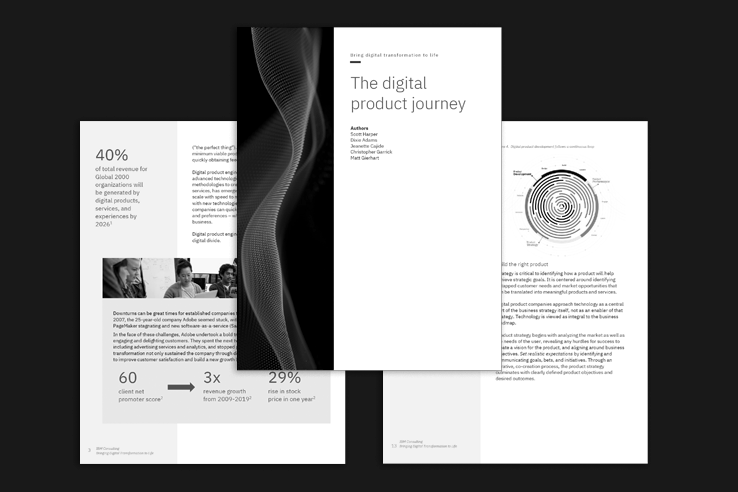We create custom digital products more or less from scratch. Every engagement has its own users, environment, and necessities, and a rigid 25-step process would inhibit our creativity and agility while working up a solution. Yet, we abide by strict rules in one area where we’re proudly inflexible: quality.
Building the right product, building it right, and making it successful all require an uncompromising commitment to quality. However, we find the traditional approach to quality management lacking, so we created our own: Collaborative Quality™.
What is Collaborative Quality?
In short, Collaborative Quality is a set of guardrails that ensure quality collaboration. These guardrails promote cooperation, sustainability, and speed across a multi-disciplinary product team.
Not long ago, quality checks occurred at the end of an engagement—an audit of the final product independent of the people who created it. This led to poor outcomes; either the wrong product was built (oops), the project failed (yikes), or perhaps worst of all, it went on indefinitely in a costly break-repair cycle (oh no).
Our trademarked approach to quality, called Collaborative Quality, avoids these pitfalls by:
- injecting a quality-first mindset into every aspect of the engagement, from the outset through delivery and performance and
- informing not what we do, but how we work together to do it.
We’ve found that predictable product delivery and end-to-end quality is the result of talented people working well together. We don’t have a quality team. Instead, every person building the product is accountable for quality. Clients will ask us “…but where are your testers?” to which we happily reply, “We are the testers!”
Baked-in quality was once a novel idea, but today other digital product engineering companies have begun taking this approach, though we’ve gotten feedback from clients that very few will provide an inside look as to how built-in quality works.
So, in the spirit of collaboration, we’re going to share our Collaborative Quality approach with you and illustrate how it speeds up time-to-value for our product engagements.
The Six Foundations of Collaborative Quality
Collaborative Quality has six foundations—similar to values or mindsets—which we collectively adopt to bring squads together that can produce value quickly. By themselves, the foundations are just ideas, which is why we’ve identified habits for each foundation (ways to put these values into action). They look like this:

Healthy teams take accountability for their work, behavior, and impact (both positive and negative). Teams should encourage practices of working toward outcomes through high quality outputs, holding yourself to a high standard, and learning from your mistakes. Create a culture of ownership each step of the way – from the moment an engagement kicks off to the final close-out.
Habits:
- Set a direction. Don’t wander aimlessly.
- Take accountability. Don’t point fingers.
- Put your learnings into practice. Don’t keep your experience secret.

Continuously Plan & Measure
Healthy teams are aware of where they are now, where they are headed, and how they are getting there. Encourage practices of delivering value gradually, cross-functional planning, and making work visible. Ensure the exercise of planning is prioritized above simply having a plan.
Habits:
- Create and maintain a plan. Don’t let your plan become irrelevant.
- Track your work and its value. Don’t lose sight of the big picture.
- Forecast progress. Don’t keep going when things don’t make sense.

Healthy teams have consistent, honest conversations about engagement progress, helping foster a trustworthy partnership. Encourage practices of providing meaningful engagement updates, discussing work in terms of value, and adjusting how we report on these things according to what resonates and makes sense with the client. Make status updates a two-way conversation, not a performance or vague presentation.
Habits:
- Have regular cadences to discuss status. Don’t make assumptions about how things are going.
- Track multiple dimensions of status. Don’t limit status to a single metric.
- Raise the flag early. Don’t avoid hard conversations.
- Adjust reporting for your audience. Don’t stubbornly stick to a template.

Healthy teams weave points of human connection throughout an engagement lifecycle to ensure a safe, inclusive environment for every individual. Encourage practices of seeking to understand each other’s points of view and ensuring a space for everyone to share. Recognize good work and be actively engaged with what your team is doing, saying, and experiencing.
Habits:
- Treat people like people. Don’t forget to connect.
- Make space for other ideas. Don’t ignore different perspectives.
- Be intentional about your team culture. Don’t downplay the importance of small actions.
- Understand who you are creating for. Don’t assume you know what people need.

Healthy teams are structured to facilitate both organic and planned dialogues, sharing, and co-creation. Encourage practices of putting intention into the smaller interactions, cross-functionally contributing, and proactively seeking to support one another. Emphasize the broader perspective, ensuring each team member remains cognizant of how their individual contributions align with the big picture.
Habits:
- Share responsibility for the work. Don’t adopt a hero mentality.
- Create shared understanding. Don’t assume we’re on the same page.
- Choose an approach that supports teamwork. Don’t throw it over the wall.

Healthy teams don’t limit quality to a role or phase. They ensure its integral presence in every team interaction, role, and work item. Encourage practices of regularly showing progress to peers, vetting ideas, and keeping a relevant definition of done. Establish regular rhythms of feedback loops to consistently enhance quality.
Habits:
- Define a shared quality standard for all work phases. Don’t assume quality is limited to a role or phrase.
- Ensure work meets the set standard. Don’t leave messes for others to clean up later.
- Seek opportunities to make things better. Don’t wait for others to notice an issue.
Drilling down even further, we point teams towards different techniques or tools to employ to express each habit. For example, feature roadmaps can help create and maintain a plan. Demos can help with reporting to clients. Empathy maps can help you understand who you’re creating for, etc.
These values and their corresponding expressions keep us aligned, allowing us to achieve a quicker time to market or time to value.
How We Put Collaborative Quality Into Practice
The Collaborative Quality foundations, their corresponding habits, and the techniques we use to employ them all live on our internal Confluence site, where everyone at the company can reference them.
At kickoff, we incorporate the six Collaborative Quality foundations directly into our plan, identifying how we will put the habits into play to build a valuable product. Throughout the engagement, team members score themselves and their teams as a whole for how well they’re following through with the foundations. Sometimes, though, an outside pair of eyes can help mitigate a roadblock. When a team gets stuck, coaches from outside the project step in to help address setbacks.
Here is an example of how Collaborative Quality might fit in an engagement:

In this example, establishing a quality agreement satisfies foundation #2, Continuously Plan and Measure. Meanwhile, building a culture of quality checks the box for foundation #5, Fostering Collaboration, and engaging with end users is critical to meeting foundation #4, Cultivate Empathy.
Collaborative Quality Creates Meaningful Products
Today, just about every product engineering company worth its salt has a baked-in quality process. The best way to tell if you’ve got a quality digital product partner is by asking yourself this question: do you know the tasks your project team is working on and more importantly how it ties back to your company objectives and can you see the actual progress?
We’ve found holding ourselves to a high standard is what creates high-value digital products.
Let’s Talk
Reach out to us so we can help you, whether you have a new product need, a new version of an existing product or want to integrate a new technology.
Contact Us








